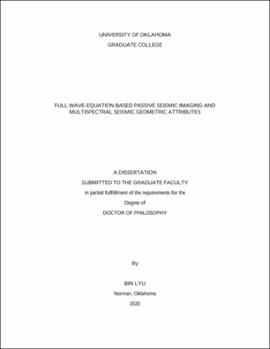| dc.description.abstract | Both passive (e.g., microseismic) and active seismic methods are used for the hydrocarbon exploration. For example, microseismic data analysis provides helpful information in not only mapping hydraulic fracture initiation, but also reservoir monitoring and even structural imaging. In 3D seismic interpretation, geometric attributes provide effective tools to map structure and stratigraphy. However, current microseismic events locating method faces challenge due to the poor resolution of passive-seismic imaging result and the dependency of the subsurface velocity model. Further, some stratigraphic features are buried in the conventional seismic geometric attributes. Focusing on these challenges, I develop new passive seismic imaging method and multispectral geometric attributes in this dissertation to provide more effective tools for hydrocarbon exploration.
To improve the quality of passive seismic imaging, I have constructed an iterative approach to locate the passive source locations and estimate the background overburden velocity based on full wave-equation methods. Specifically, I use a high-resolution geometric-mean reverse-time migration (GmRTM) to provide source locations that are better focused compared to conventional time-reversal imaging method. I also use the passive-source full-waveform inversion (FWI) to optimize the overburden velocity model. Given this accurate velocity, I use passive-source reverse-time migration to provide a structural image. Numerical experiments on the Marmousi model dataset indicate that the proposed approach can handle complicated structures and noisy seismic recordings.
Recent developments in multispectral coherence based on simple band-pass filters show improvements in fault and stratigraphic edge delineation. To further improve this technology, I evaluate several different spectral decomposition algorithms to determine which, if any provide superior coherence images, I find that exponentially-spaced spectral voices provide better coherence images than linearly-spaced spectral components for the same computation cost. I also find that multispectral coherence computed from generated using the high-resolution maximum entropy algorithm provides reduced noise and better resolution of thinner channels than the other spectral decomposition algorithms.
Equally important, I analyze why multispectral coherence provides more continuous fault images where conventional coherence images often exhibit gaps in areas where a human interpreter would draw a single, unbroken fault. These coherence fault occur when the displacement across the fault aligns different stratigraphic reflectors, resulting in what appears to be a continuous reflector. This same alignment also confounds auto-pickers. Although two different broadband seismic reflectors may be aligned across faults, in general, the corresponding spectral voices are not, thereby reducing their cross-correlation, and for multispectral coherence, elements in their covariance matrices, across the fault.
Considering that multispectral coherence provides a better delineation of the seismic discontinuities due to data quality, thin-bed tuning, or non-stratigraphic alignments, I further investigate multispectral dip attributes, which try to combine the benefits from different spectral voices. I illustrate the multispectral gradient structure tensor (GST) dip method, which helps improve the quality of dip attributes in the conventional broadband dips. Multispectral GST dip is performed by computing the eigenvectors and eigenvalues from the multispectral gradient structure tensor matrix. I use two 3D seismic surveys to indicate the improvement using the multispectral GST dip over conventional broadband dip attributes. | en_US |
